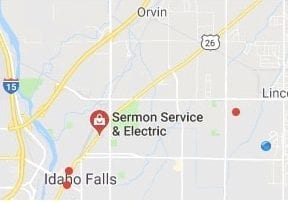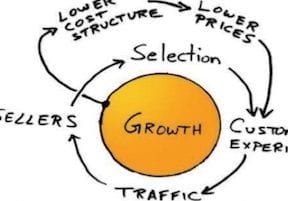Keywords are an important building block for ecommerce marketing. Developing and maintaining a keyword list may help an ecommerce business understand shoppers and do a better job of marketing to them.
In the context of search engine optimization, searchers’ words or phrases summarize intent — the searchers’ thoughts, questions, or needs. Those keywords represent the language people use to ask for help finding resources online.
Search engines like Google, Bing, and Yahoo are successful when they properly interpret keywords and connect users with answers or solutions online.
For marketers, keywords represent an opportunity to (a) speak a shopper’s language, (a) draw insights from the words shoppers choose, (c) help connect those consumers to the products or services they want, and (d) generate profit in the process.
The better a marketer understands the language consumers use to find a company’s products, the more that marketer understands about the needs and wants of those prospects, and the better those needs and wants can be described in, say, blog posts, on social media, or even in advertising.
Idea and Purpose
To develop your keyword list, start with your store’s main idea. What is the one simple phrase that describes what your ecommerce business is or does?
Does your online shop sell “discount fishing supplies” or, perhaps, “men’s fashion clothing”? Is your website a place to “discover new toys and games” or find products on “technology’s bleeding edge”?
You can ask friends or business associates to help you think of the best phrases to describe what your ecommerce business is about. You could also conduct a focus group with representatives from your primary customer groups.
Collect these keyword phrases into an initial list.
Products and Categories
Next, add to your list keywords and phrases for important products and categories.
To start with, what are the headlines your company uses to describe product categories?
As an example, look at the departments on Amazon. You will find product categories, such as “Home, Garden & Tools,” that have long lists of subcategories, including “Kitchen & Dining,” “Furniture,” and “Bed & Bath.”
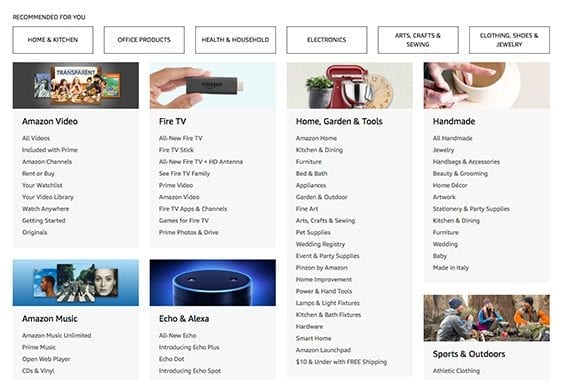
The words an online store uses to describe product categories should be some of that store’s strongest keywords. Image: Amazon.
Each Amazon product subcategory may also have more refined categories beneath it. Under “Furniture” a shopper can browse for bedroom furniture, living room furniture, kids’ furniture, and even entryway furniture.
Add all of these sorts of product terms to your initial list of keywords.
Refine Keywords
Head to a search engine and begin testing your initial keywords, making sure you are using the “private” or “incognito” mode of your browser (otherwise, your personal browsing habits could influence the search results). See how the search engine interprets a given keyword or phrase and what words or combination of words your competition is using.
Understand how your keyword is matching the results that, say, Google served up. This test may lead you to add keywords to your list, or remove them.
As an example, a brick-and-click, omnichannel retailer in the United States had the term “snow thrower” on its list of keyword phrases.
It used this term because that was how the manufacturer of the product described the machine. It was a snow thrower. But when one searches for the phrase “snow thrower” on Google, it is clear that most of the competition is using the term “snow blower.”
A sample search conducted in January 2018 returned three ads and a page full of organic results. While the ads tended to use the original phrase, the top organic results for “snow thrower” included the keyword “snow blower.”
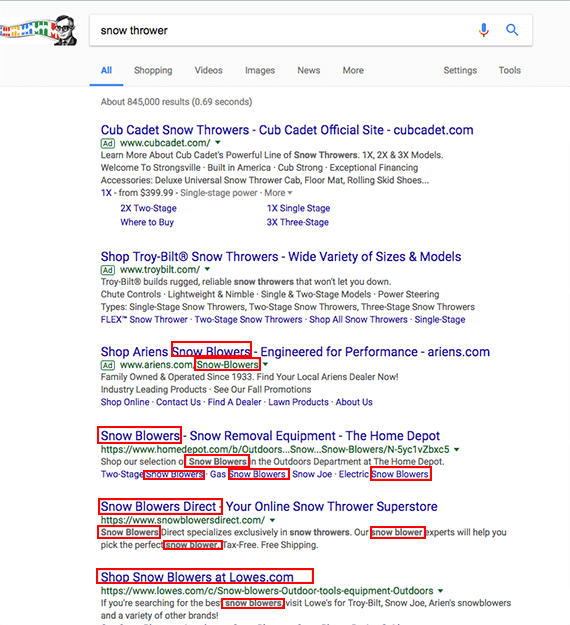
The top organic results for the phrase “snow thrower” were sites that actually used the term “snow blower.” This may be an indication that consumers use a different term than do manufacturers. Some retailers, such as Home Depot and Lowe’s, have figured this out.
While it is clear that Google considers these terms to be synonyms, it may be a good idea to either add “snow blower” to the list of keywords or use it to replace “snow thrower.”
To help decide which phrase is better or whether you need to add a keyword or replace one, consider using Google Trends. This tool allows you to compare the relative interest (number of queries) for two or more keywords over time.
For example, in the first week of January 2018, there were about 10 times as many searches for “snow blowers” than for “snow throwers.”

Google Trends allows you to compare the relative number of searches for two or more keywords. This can be helpful.
You may also try keyword variations in Google Trends. What happens, for example, when you compare “snowblower” and “snowthrower” to “snow blower” and “snow thrower”?
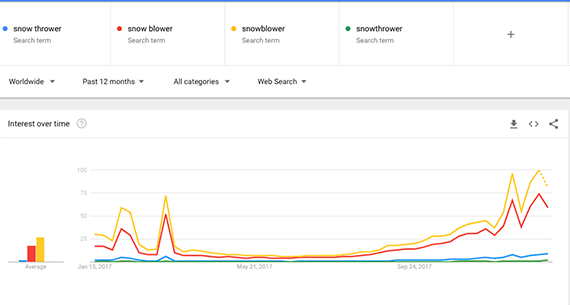
“Snowblower” as one word is relatively more popular than “snow blower” as two.
Keyword Tools
Continue adding to your list of keywords with some help from software tools.
For example, there are good keyword research platforms, such as SEMrush, Raven Tools, Wordtracker, Linkdex, and Ubersuggest, to name a few.
Webmaster tools from Google or Bing also include solutions that help identify keywords from your site’s content.
Look, also, at your analytics data to discover how existing traffic is finding your site on search engines. What are the keywords that are already working to drive traffic? Are there different keywords for mobile traffic?
Also, Google’s Keyword Planner in AdWords can identify popular keywords in your niche.
Each of these solutions can help expand your list.
Next Steps
At the end of this process, you should have an extensive list of the words and phrases that describe your ecommerce business and its products.
Building the list is the first step in a successful keyword marketing strategy. Then, refine the words and phrases, considering long-tail additions and prefixes and suffixes. Draw some conclusions about your customers and prospects from the words they use to talk about your business and the products it sells.
Then use the keyword list to inform your marketing. Review the list as you plan site content, edit product descriptions, create on-site merchandising, and buy pay-per-click ads.


